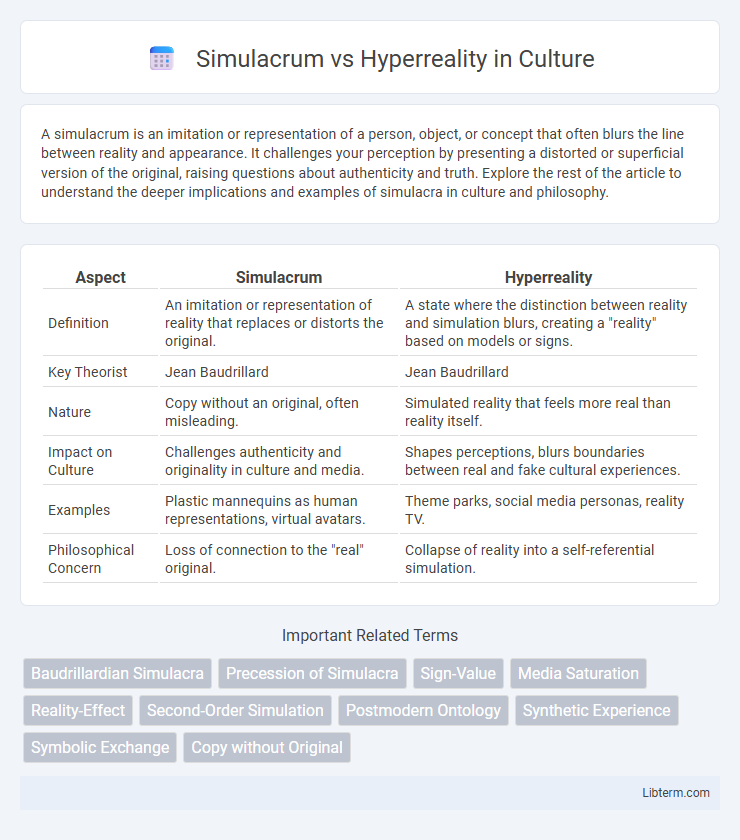A simulacrum is an imitation or representation of a person, object, or concept that often blurs the line between reality and appearance. It challenges your perception by presenting a distorted or superficial version of the original, raising questions about authenticity and truth. Explore the rest of the article to understand the deeper implications and examples of simulacra in culture and philosophy.
Table of Comparison
| Aspect | Simulacrum | Hyperreality |
|---|---|---|
| Definition | An imitation or representation of reality that replaces or distorts the original. | A state where the distinction between reality and simulation blurs, creating a "reality" based on models or signs. |
| Key Theorist | Jean Baudrillard | Jean Baudrillard |
| Nature | Copy without an original, often misleading. | Simulated reality that feels more real than reality itself. |
| Impact on Culture | Challenges authenticity and originality in culture and media. | Shapes perceptions, blurs boundaries between real and fake cultural experiences. |
| Examples | Plastic mannequins as human representations, virtual avatars. | Theme parks, social media personas, reality TV. |
| Philosophical Concern | Loss of connection to the "real" original. | Collapse of reality into a self-referential simulation. |
Understanding Simulacrum: Definitions and Origins
Simulacrum refers to a representation or imitation of a person, object, or concept that may lack an original or authentic reference. Originating from the Latin term "simulacrum," it was extensively explored by philosopher Jean Baudrillard, who posited that simulacra are copies without originals existing within media and culture. This concept highlights the blurring boundaries between reality and representation, where simulacra influence perception and social constructs.
Hyperreality Explained: Concept and Context
Hyperreality, a concept developed by philosopher Jean Baudrillard, describes a condition in which reality is replaced or obscured by a simulated version that feels more real than the original. This phenomenon occurs in media, advertising, and digital environments where signs and images create a perception that blurs the line between reality and simulation. Hyperreality challenges our understanding of authenticity by making simulations indistinguishable from or even preferable to reality itself.
Historical Roots: Baudrillard’s Theories on Simulacra
Jean Baudrillard's theories on simulacra trace the historical roots of hyperreality by illustrating how signs and symbols detach from their original meanings to create copies without an authentic referent. His framework outlines four stages of the image: from a faithful representation to a mask concealing the absence of reality, ultimately culminating in hyperreality where simulations replace all sense of the real. This shift disrupts traditional notions of truth and authenticity, emphasizing the dominance of mediated experiences over direct engagement with reality.
Differences Between Simulacrum and Hyperreality
Simulacrum refers to a copy or representation of an original object or concept that may distort or omit aspects of the original, whereas hyperreality describes a condition where the distinction between reality and simulation blurs, creating a new, perceived reality that replaces the original. Simulacrum is concerned with imitation and replication, often highlighting how representations can become detached from their sources. Hyperreality, on the other hand, involves the saturation of simulated experiences, where simulations become more real or meaningful than actual reality, influencing perception and social behavior.
The Role of Media in Constructing Hyperreality
Media plays a crucial role in constructing hyperreality by creating simulations that replace or distort reality, making it difficult to distinguish between the real and the fabricated. Through constant reproduction and circulation of images, narratives, and symbols, media generates a simulated world where the representation becomes more influential than the original experience. This process transforms society's perception, fostering a hyperreal environment where simulations no longer refer to any external reality but instead stand as their own independent truths.
Everyday Examples of Simulacra in Modern Society
Simulacra in modern society appear in virtual reality environments, social media personas, and branded experiences that replicate or distort reality. These everyday examples blur the line between authentic experiences and constructed simulations, creating representations that replace or simulate actual objects or events. This phenomenon illustrates how images and symbols increasingly shape perception, leading to a hyperreal condition where the distinction between reality and simulation is irreversibly dissolved.
Hyperreality in Digital Culture and Virtual Worlds
Hyperreality in digital culture and virtual worlds refers to the creation of immersive environments where simulations blur the boundaries between reality and artificiality, often surpassing authentic experiences. Virtual worlds, such as MMORPGs and metaverses, generate hyperreal spaces where users interact with digital avatars and environments that feel more vivid and appealing than the physical world. This phenomenon challenges traditional notions of identity and presence, as digital representations and experiences increasingly influence perceptions of reality.
Impacts of Simulacrum and Hyperreality on Perception
Simulacrum distorts perception by replacing reality with copies lacking original meaning, leading individuals to accept artificial representations as genuine. Hyperreality intensifies this effect by creating immersive experiences where distinctions between reality and simulation blur, altering how people interpret truth and authenticity. Both phenomena reshape consciousness, influencing social behavior and cognitive processes through fabricated environments and symbolic exchanges.
Philosophical Implications: Reality Versus Illusion
Simulacrum and hyperreality challenge traditional notions of reality by blurring the boundaries between the authentic and the fabricated, raising profound philosophical questions about perception and existence. Simulacra represent copies without originals, while hyperreality signifies a condition where distinctions between reality and simulation collapse, creating a new perceived reality. These concepts prompt a reevaluation of truth, identity, and the nature of human experience in a media-saturated world.
Simulacrum and Hyperreality in Popular Culture
Simulacrum in popular culture often manifests as copies or representations that lack an original, highlighting the blurred boundaries between reality and imitation in media like film, video games, and virtual reality. Hyperreality intensifies this concept by creating experiences and environments that feel more real than reality itself, evident in theme parks, social media, and augmented reality applications. Both concepts challenge perceptions of authenticity and truth, shaping contemporary narratives and consumer engagement.
Simulacrum Infographic

 libterm.com
libterm.com